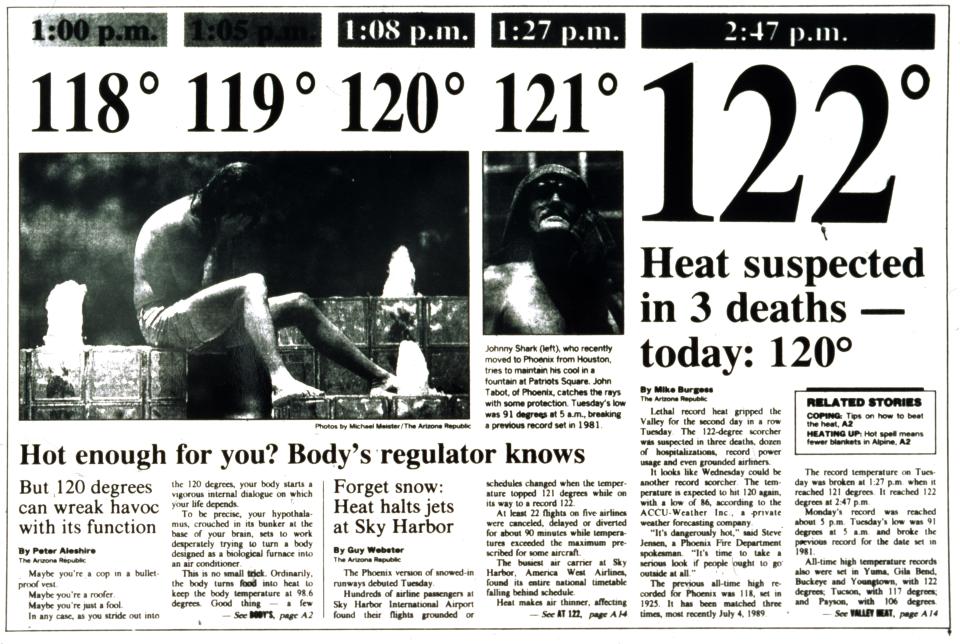How much of the heat can we blame on the heat island?

Any story of dramatic survival in a desert environment is sure to involve a scene in which the main, parched character gleefully spots water in the distance, only to arrive and find it has disappeared. As the sun and daytime temperatures continue to rise, the protagonist becomes increasingly disoriented and this alarming situation occurs again and again.
In addition to being a movie scene, these mirages are an optical phenomenon that occurs when the sun heats up a surface that then radiates heat back into the air just above it, causing a difference in temperature between the air immediately above the ground and the air in your field of vision at eye level. When you glance ahead and down, this contrast causes the light heading towards your eyes to refract, or bend, as it crosses this air temperature barrier, which results in the squiggly appearance of something that looks like water.

While that puddle in the distance will (almost) never be real (but don't give up hope), that hazy heat emanating from the desert surface can have serious impacts on people trying to survive daily life in mirage-prone landscapes like Arizona. In 2021, the Maricopa County Department of Public Health reported 252 cases of heat-associated deaths, with 72% of those occurring outdoors.
Scientists have long understood that paving over the desert surface with concrete or asphalt or new apartment buildings increases the amount of solar heat that is absorbed during the day and then released back into the city air at night. This tendency of urbanized environments to become hotter than their natural surroundings is called the "urban heat island," or the "urban heat effect."
But scientists also understand that the built environment is not the only thing causing city temps to rise. The climate around us is warming, too — largely because of the effects of greenhouse gases, which are emitted into the atmosphere by, primarily, the burning of fossil fuels.
The question, when it comes to our hotter city, is how much of that rising heat can be attributed to one source vs. the other.
The role of the built environment
Between 2010 and 2020, Maricopa County built more than 173,000 new housing units, according to the latest report from the U.S. Census Bureau, along with extra roads, stores and offices to accommodate those new residents. Over that same time period, the average annual temperature in Phoenix, as recorded by the National Weather Service, rose by about two degrees Fahrenheit.
“For a city like Phoenix, which 50 years ago was just a small dot on the map, the more you build the more you warm," said Matei Georgescu, a professor of Geographical Sciences and Urban Planning at Arizona State University who specializes in urban heat studies.
Drawing on a decade of work, Georgescu estimates that roughly half of recent warming in the Phoenix metro area is due to the expansion of man-made structures that absorb solar energy. The rest is due to greenhouse gases.
The climate and urbanization: Population growth brings greater climate risks to metro areas, report says, but also hope
To conduct this work, Georgescu and colleagues at ASU first calibrated a computer model to the natural properties of heatwaves, temperature fluctuations and the regional climate. Then they added in the built environment over time, increasing in their model the proportion of land covered by impermeable, man-made surfaces that retain more heat than soil or plants. Eventually they had a computerized representation of what urbanization in the sun belt might look like in 2050.
They then compared the results of that simulation to a climate model output over the same area and time period that did not include the built environment, but did include effects due to greenhouse gases.
“Our results indicate that the effect of warming due to the built environment is similar in magnitude to the effect of warming from greenhouse gases," said Georgescu.
The models do have limitations, of course, as any predictions about the future do.
"We're not smart enough to say, 'Well, warming in some neighborhood in Tempe is going to be 20% due to the built environment and 80% due to greenhouse gases. That's not the point. The point here is that one cannot neglect the urban environment when calculating the totality of warming that is anticipated for the future."
Also at ASU, Patrick Phelan, a professor in the School of Engineering of Matter, Transport and Energy, is hard at work on a project aimed specifically at not neglecting the issue of warming in the urban environment. He says that machinery is less efficient at higher temperatures, which kicks off a vicious feedback cycle of worsening conditions.
"Thermodynamics tells us that, the hotter the temperature at which you have to reject heat from an engine, the worse it’s going to perform and the more emissions you’re going to get," he explained. "That translates into more and more climate change, and then the engines have to work even harder."
To help stem this tide, Phelan directs the ASU branch of a U.S. Department of Energy project that trains engineering students to evaluate how small and medium-sized manufacturing companies might be able to reduce their energy usage and improve the efficiency of their machinery. Companies can visit the Industrial Assessment Center website to learn more and request this free service.
"Not everybody recognizes that global warming is a problem, but I think people recognize that urban heat islands are a problem," Phelan said. "So what can we do about it? Well, one of the things is to get people to use less energy. And so this is one of the ways that we can encourage that."
The role of the changing climate
That globally warming temperatures are a problem driven not only by the built environment but also by emissions from, for example, poorly-functioning engines was further illuminated for Georgescu and colleagues when, in a later study, they broke their model projections down into three-hour segments.
"With results not averaged for an entire summer, but for every three hours, we could say when the effect of the built environment on warming is greatest during the 24-hour portion of the day relative to the effect of greenhouse gases," Georgescu said.
Climate series beginning: Phoenix isn't what it once was because of climate change. But it's not too late to save it
They found that, while the built environment prevents temperatures from dropping to previous lows overnight, it's the influence of increased concentrations of greenhouse gases in the air that dominate daytime temperature increases.
"The effect of increased emissions of greenhouse gases is consistent throughout the 24-hour period, while the effect of the growing city is greatest during the evening and nighttime hours and is minimal or negligible during the daylight hours," Georgescu said.
This can be seen in temperature records dating back to 1948 from a National Weather Service station at Phoenix's Sky Harbor International Airport, perhaps one of the most paved parts of the metro area and one of the busiest with modern heat-generating engines. The average annual temperature climbs from 69.7 degrees Fahrenheit in 1948 to 77.2 degrees in 2020, while the annual minimum warmed more quickly, from 22 degrees in 1948 to 35 degrees in 2020.
This more dramatic increase in overnight lows can be explained by the dual influence of climate change plus urban development, Georgescu said. But any daytime average increase observed over long periods of time would be due solely to climate change.
It's those climate-driven daytime maximums that have had consequences at Sky Harbor. In 1990, when daytime temperatures hit 122 degrees Fahrenheit, the airport grounded planes because it had no data on how well their engines would function in those conditions. Air density and temperature influences the physics of flying, and these were uncharted skies. It happened again in 2013 and then again in 2017 when the NWS's Sky Harbor thermometer hit 119. The airport has only gotten bigger and busier over time.

"It's probably not going to be that long from now that the minimum temperature at Sky Harbor will not dip below 100 degrees Fahrenheit," Georgescu said.
The complexities of climate change and what exactly is behind rising average temperatures and increasingly weird weather can sometimes feel like some sort of optical illusion, like the desert is playing tricks on your dehydrated mind. But often science can explain how phenomena we do see aren't real while other forces we can't see very much are.
For those who still doubt the role of climate change and greenhouse gases in rising urban temperatures, Georgescu has just one final message:
“Come to my classes. I teach Intro to Climatology. I’m totally serious. People need to educate themselves and be open to a discussion with those who are experts in the field.”
Joan Meiners is the climate news and storytelling reporter at The Arizona Republic and azcentral.com. Before becoming a journalist, she completed a Ph.D. in Ecology. Follow Joan on Twitter at @beecycles or email her at joan.meiners@arizonarepublic.com.
This article originally appeared on Arizona Republic: Heat island or greenhouse gases? Which is more to blame for heat?

